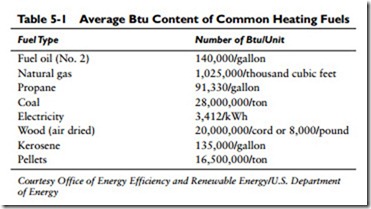Only the principal characteristics of those heating fuels used for domestic heating purposes will be considered in any great detail in this chapter. Descriptions of firing methods for the more commonly used heating fuels are found in Chapter 1, “Oil Burners,” Chapter 2, “Gas Burners,” Chapter 3, “Burning Solid Fuels” in Volume 2, and Chapter 3, “Stoves, Fireplaces, and Chimneys” in Volume 3.
Heating fuels are measured in physical units, such as gallons (fuel oil, propane, and kerosene), cubic feet (natural gas), tons (coal and pellets), kilowatt hours (electricity), and cords or pounds (wood).
Another way to measure heating fuels is by heat content. The British thermal unit (Btu) is the value commonly used in the United States for expressing the energy value or heat content of a heating fuel. One Btu is the amount of energy required to raise the temper- ature of 1 pound of water 1 degree Fahrenheit (°F), when the temperature of the water is about 39°F. The average Btu contents of different heating fuels are listed in Table 5-1.
The heating fuel values listed in Table 5-1 are the gross (or higher) values commonly used in energy calculations in the United States. These values are estimated by the Energy Information Administration in the Annual Energy Review and other sources. Net (or lower) heating values may also be used in energy calculations.
When a fuel is burned in an appliance (e.g., a furnace or boiler), the combustion process causes the water contained in the fuel to vaporize. The water vapor contains heat energy, which is lost when the combustion gases are vented to the exterior. The difference between the higher and lower heating values is the amount of energy required to vaporize the water contained in a fuel or created in the combustion process. This difference can range from approximately 2 to 60 percent, depending on the fuel used.
Note
The newer, high-efficiency, condensing forced-air furnaces are designed to capture much of the heat energy contained in the water vapor before it exits the furnace stack and enters the chimney. Because electricity is not burned in a combustion process, there is no difference between a gross (higher) and net (lower) value.
Heating fuels also can be classified as solid, liquid, or gaseous, depending upon their physical state. Examples of solid fuels are coal and coke. Fuel oils are classified as liquid fuels; gaseous fuels include natural gas, manufactured gas, liquefied petroleum gas, and related types.
Natural Gas
Natural gas is a generic term commonly applied to those gases found in or near deposits of crude petroleum. It is not connected with the production of oil and should always be regarded as a sep- arate and independent entity. Natural gas is piped under pressure from the gas fields to the consumer centers, and these pipelines now serve a considerable portion of the United States.
Natural gas is the richest of the gases and contains from 80 to 95 percent methane with small percentages of the other hydrocar- bons. The heating value of natural gas varies from 1000 to 1200 Btu/ft3, with the majority of gases averaging about 1000 Btu/ft3. The caloric value will depend upon the locality.
Natural gas can be divided into three basic types:
1. Associated gas
2. Nonassociated gas
3. Dissolved gas
Associated gas is a free (undissolved) natural gas found in close contact with crude petroleum. Nonassociated gas is also a free gas but is not found in contact with the crude petroleum deposit. As the name suggests, dissolved gas is found in solution in the crude petroleum.
Manufactured Gas
A manufactured gas is any gas made by a manufacturing process. Raw materials used in the production of manufactured gas include coal, oil, coke, natural gas, or one of the other manufactured gases. For example, coal gas is made by distilling bituminous coal in either retorts or by-product coke ovens. Often several of these raw materials are used together as a base for the production of a manufactured gas.
The types of manufactured gases commercially available include:
1. Coal gas or by-product coke-oven gas
2. Oil gas
3. Blue water gas
4. Carbureted water gas
5. Producer gas
6. Reformed natural gas
7. Liquefied petroleum gas
Most of these gases have low caloric values (generally between 500 and 100 Btu/ft3) and are produced primarily for industrial use. Producer gas and liquefied petroleum gas are also used for domes- tic purposes. The former may be used alone or in combination with other gases. Of all the manufactured gases, liquefied petroleum gas enjoys the widest application in domestic heating and cooking.
Related posts:
Incoming search terms:
- difference between natural gas and manufactured gas
- difference between manufractue fuel and natural fuel
- what is the difference between natural fuel and manufactured fuel?
- what is the difference between natural and manufactured fuels
- the different between natural and manufactured fuel
- how is manufactured gas different from natural gas
- differentiate between natural gas and manufactured gas
- different between manufactured fuel and natural fuel
- different between manufacture and natural fuel
- differences between natural gas and manufacturerd gas
- differences between natural gas and manufactured gas
- Difference between natural gas and maufactured gas
- difference between natural and manufactured fuels
- what is the differents between natural fuel and manufactured fuel
